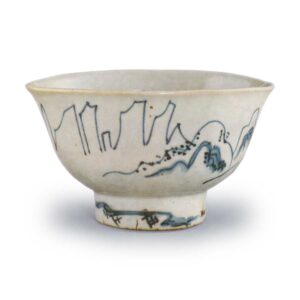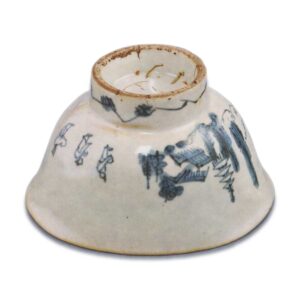

Hatakeyama Memorial Museum
Height: 7.6-8.7cm
Diameter: 11.1-13.9cm
Foot diameter: 6.2cm
Height: 2.0cm
There is a type of Chinese pottery known as “Gosu” in Japan. Gosu is also written as “Goshu”, and Gosu-akae is famous among tea ceremony masters and pottery lovers because there are many examples of it.
It is thought that they were made at the Shitan Kiln in Longxi County, Fujian Province, at the end of the Ming Dynasty, but in Europe and America they are known as Swatou Ware.
The most common type of gosu ware is called gosu-akae or akae-gosu, and is characterized by its liberal use of seven different colors, including red, green, yellow, purple and black, in large dishes, skewers and the like. It seems that they were mass-produced as export goods at the end of the Ming Dynasty, and there are countless numbers of artifacts in our country, the Philippines, and various places in Southeast Asia, and they have even been discovered in the ruins of Fustat in Egypt. Fustat, in Egypt. However, none of the pieces that have come down to us in China have ever been seen before, and the reason that not a single piece of Gousu-akae is on display in museums around China is probably because there are almost no pieces left in China, or even if there are, they are not recognized for their value at all.
In addition to the blue and red overglaze enamels, the Shidou Kiln also produced blue and red overglaze enamels, blue and red overglaze enamels, brown overglaze enamels, white porcelain with a plain white glaze, and celadon porcelain. The base material is all porcelain, and the characteristic of this kiln is that the bottom of all the pieces has a layer of sand baked on.
Most of the blue and indigo-blue glazed wares were mass-produced as export wares, but there are some blue and indigo-blue glazed wares that were ordered from Japan and made as tea utensils around the end of the Ming Dynasty, during the reigns of Emperor Tianqi or Emperor Shuzheng. This tea bowl, with a landscape design on the body, is an example of this type, and there are very few similar examples. This is another example of a tea bowl with a horse design on the body, made with a diamond-shaped cedar glaze called “Gosu no hikoma”, but this is also a rare example of a similar product.
Unlike Jingdezhen, which produced Kosometsuke and Shonzui, the Shitan kilns were located in Fujian, and there was probably little connection with Japan, so there are very few examples of works in the Kosu-te style that are thought to have been ordered from Japan. It can also be said that this is a rare type of pottery that is found only in Japan today and nowhere else in the world.
This tea bowl, with its simple landscape design in underglaze blue and overglaze white, has a dull, characteristic underglaze blue body, and a relatively thick layer of transparent white glaze has been applied to the entire surface. The underglaze blue has been used to depict a majestic mountain range, and figures, trees and a temple-like structure have been added to this. The shape has a slightly upturned rim and a distorted body, and it has a tall, large footring, which is unique to Fujian Province. The sand-glazed tatami mat is a characteristic of the Wusu-te style, and the inside and bottom are plain white.
The underglaze blue used to depict the landscape is called “dochei” and is made in China. Because it contains a lot of impurities, it has a dull indigo color, and in some places it has a blackish color due to the iron content. However, the charm of the indigo underglaze is in the lower part of the painting, and the most attractive thing about this teacup is the imposing distant mountains drawn in the style of the bone method.



